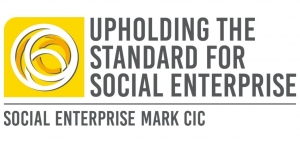All we want for Christmas is… freedom (not just from Covid!)
 Central to social enterprise is the principle that the generation of revenue from customers can be used to create a business that uses this revenue to create social value. Alongside this, that the reinvestment of any/most profit, can allow us to address social and environmental justice, thus transforming society for the better, rather than for shareholder gain. The Social Enterprise Mark requires that this principle is written into the constitution and governing documents.
Central to social enterprise is the principle that the generation of revenue from customers can be used to create a business that uses this revenue to create social value. Alongside this, that the reinvestment of any/most profit, can allow us to address social and environmental justice, thus transforming society for the better, rather than for shareholder gain. The Social Enterprise Mark requires that this principle is written into the constitution and governing documents.
we need to be clearer about the detrimental effects that growth for growth’s sake have on the delivery of social value and justice
The main argument against this asset locked model is often that it doesn’t facilitate equity investment as investors want to make a profit either through shareholder dividends or from a sale of the business as they exit. Equity investment is a tool used to enable the company to scale/grow quickly.
The main arguments against equity investment however are a loss of control to outside influencers that have different motivations and a potential mission drift as investors require a financial return. I would also add that we need to be clearer about the detrimental effects that growth for growth’s sake have on the delivery of social value and justice. In particular, very large social enterprises can end up displacing smaller grassroots community-led businesses that may well create greater social value.
 When we look back to the early days of social enterprise, there was not this urge to scale up and copy the standard business/corporate model. Social enterprises worked together and supported one another in order to increase their social impact – the emphasis was on identity not trade – this was well articulated by our friend Ed Mayo in a guest blog written for us in January. He also mentioned that this has had its limitations in terms of scale and argues for a scaling out model (i.e. working more effectively together to combine resources).
When we look back to the early days of social enterprise, there was not this urge to scale up and copy the standard business/corporate model. Social enterprises worked together and supported one another in order to increase their social impact – the emphasis was on identity not trade – this was well articulated by our friend Ed Mayo in a guest blog written for us in January. He also mentioned that this has had its limitations in terms of scale and argues for a scaling out model (i.e. working more effectively together to combine resources).
This ‘living within your means’ business approach is known as ‘bootstrapping’ but has become unfashionable because of its perceived limitations in scaling up the business. However, as Ed points out, there are ways that we could be promoting this model in order to maintain our values, creating focus as well as maintaining control of the outcomes whilst addressing the scale issue by working more effectively together. For instance, we can address unfashionable challenges and market gaps using the bootstrapping model, because we don’t need to persuade others of our ‘pitch’.
I might stick my neck out and say that the majority of social enterprises are using the bootstrapping model, but it gets little profile as it is perceived as lacking by most current business thinkers. This is one of the reasons that social enterprises have not been attracted to social investment – or any other types of investment for that matter.
Until we live in a time where investors are not just motivated by financial return, we need an approach that is fit for our social/environmental purpose and gives us the freedom to reinvest primarily in the mission that we set out to address.





Leave a Reply
Want to join the discussion?Feel free to contribute!